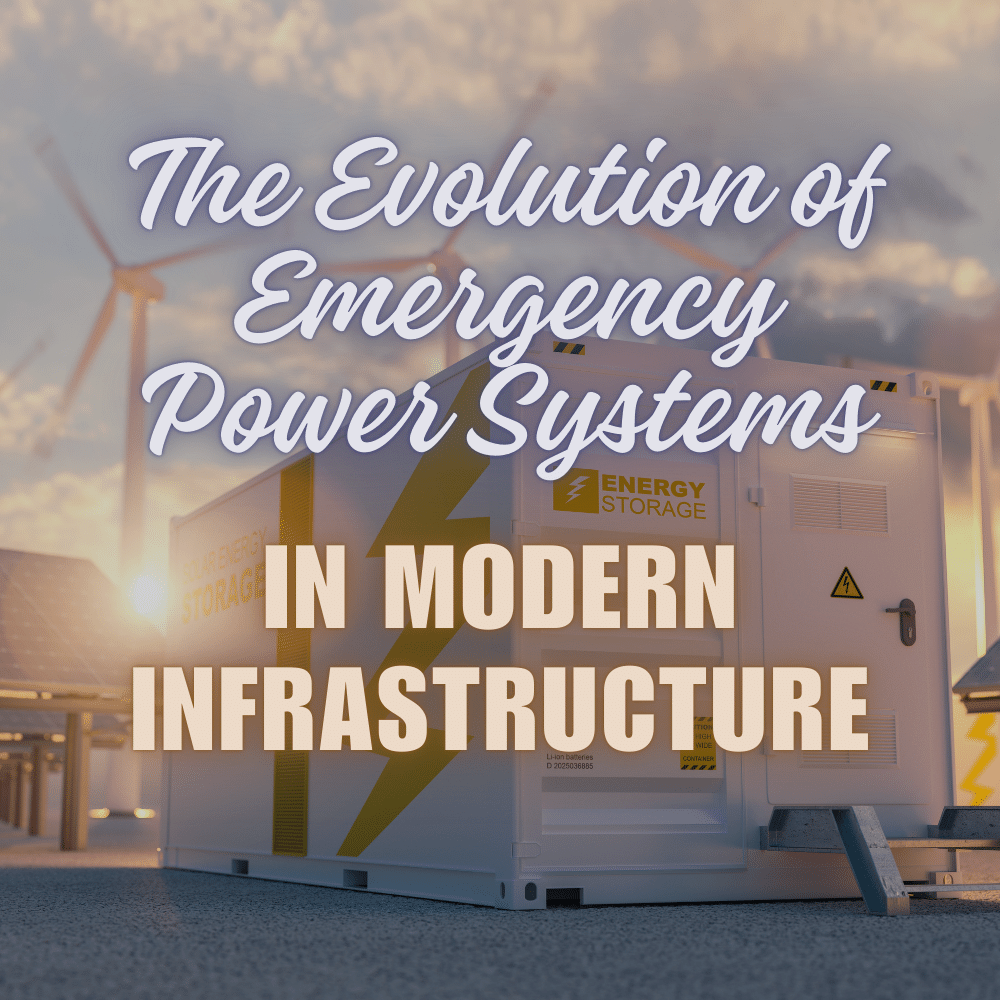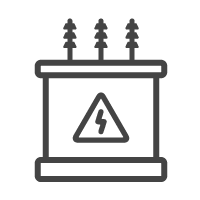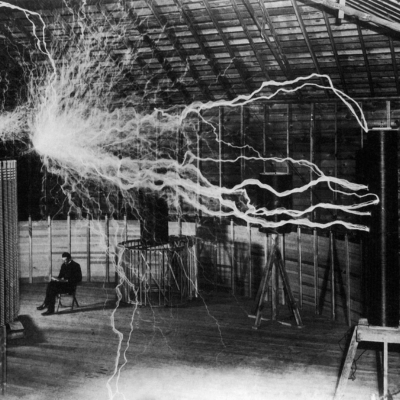Blog Posts
The Evolution of Emergency Power Systems in Modern Infrastructure

Emergency power systems have evolved significantly from their early iterations to become a cornerstone of modern infrastructure. This blog post delves into the fascinating history of these systems, highlighting key advancements and technological breakthroughs.
We’ll explore how emergency power generation has become essential across various sectors, ensuring operational continuity and safety. From healthcare to industrial applications, the role of emergency electricity sources cannot be overstated.
As we look into the future, we’ll also discuss emerging trends and how innovation continues to shape the landscape of emergency power solutions.
Introduction to Emergency Power Systems
Emergency power systems, designed as a lifeline in power outages, have become an integral part of modern infrastructure. These systems provide critical backup, ensuring continuity and safety during unexpected power failures. Initially developed to address essential needs in specific sectors, they have evolved to encompass a broad range of applications.
This introduction serves as a gateway to understanding the fundamental aspects of emergency power systems, including their purpose, basic components, and the role they play in various industries. We’ll uncover how these systems function and why they are indispensable in our increasingly power-dependent world.
Defining Emergency Power Systems in Today’s World
In today’s world, emergency power systems are essential frameworks designed to provide electricity during main power grid failures. These systems are no longer just about providing basic backup power; they have evolved into complex setups that ensure uninterrupted operations in critical facilities like hospitals, data centers, and industrial plants.
This definition encompasses a range of technologies, from traditional generators to innovative renewable energy sources, highlighting their pivotal role in maintaining continuity and safety in a variety of sectors. Understanding these systems in the modern context is key to appreciating their significance in our power-reliant society.
The Critical Need for Reliable Emergency Electricity Sources
The critical need for reliable emergency electricity sources in modern society cannot be overstated. In a world increasingly dependent on electrical power, the absence of a stable power supply can lead to dire consequences. From hospitals requiring uninterrupted power for life-saving equipment to data centers needing to secure crucial data, the role of emergency power is pivotal.
It ensures the functioning of essential services and safety systems during power outages. As such, investing in robust and dependable emergency power solutions is not just a matter of convenience but a fundamental aspect of ensuring public safety and operational continuity across various sectors.
Historical Development of Emergency Power Systems
The historical development of emergency power systems is a journey marked by significant technological advancements. Originating from basic generators used to provide electricity during outages, these systems have evolved into sophisticated setups. This evolution has been driven by the increasing reliance on electrical power in various sectors and the need for uninterrupted power supply for critical operations.
Over the years, innovations in technology have led to more efficient, reliable, and environmentally friendly emergency power solutions, adapting to the growing complexity of power needs in modern society. This historical progress underscores the importance of emergency power systems in today’s world.
Early Forms of Emergency Electricity Sources
The early forms of emergency electricity sources were relatively basic compared to the advanced systems we have today. Initially, they were primarily mechanical generators that converted physical energy into electrical power. These generators were often driven by steam or internal combustion engines, providing a rudimentary but vital source of power during outages. Their development was crucial in the early days of electrical dependency, laying the groundwork for more sophisticated emergency power technologies. This phase marked the beginning of an era where the concept of having a backup power source started to gain importance in industrial and urban settings.
Milestones in Emergency Power Generation Technology
Milestones in emergency power generation technology have been pivotal in shaping the reliability and efficiency of modern power systems. Key developments include the transition from manual to automatic transfer switches, enhancing the speed and reliability of switching to backup power. The advent of diesel generators brought more robust and longer-lasting power solutions. Further, the integration of renewable energy sources, like solar and wind, into emergency power systems marked a significant stride towards sustainability.
The digitalization of power management systems, allowing for real-time monitoring and control, represents a recent breakthrough, further ensuring the reliability and effectiveness of emergency power solutions in a variety of settings.
Types of Emergency Power Systems
Emergency power systems come in various types, each suited to different needs and scenarios. The most common types include:
1. Uninterruptible Power Supplies (UPS): These provide instant power to a load when the input power source fails. They are typically used for short-term power outages and are essential in data centers and for sensitive equipment.
2. Standby Generators: Often powered by diesel or natural gas, these generators kick in during prolonged power outages, commonly used in hospitals, commercial buildings, and industries.
3. Battery Backup Systems: Employing large batteries, these systems store electrical energy and provide power during an outage. They are becoming increasingly popular in conjunction with renewable energy sources.
4. Inverter Systems: These convert DC power from batteries or solar panels to AC power and are used in various settings, including residential and remote locations.
Each type of system has its unique features and is chosen based on factors like the duration of backup required, load capacity, and specific application needs.
Traditional vs. Modern Emergency Electricity Sources
Traditional emergency electricity sources primarily revolved around diesel and gas-powered generators, which were valued for their reliability and capacity to power large facilities. These generators, however, often required significant space and emitted pollutants.
In contrast, modern emergency power sources have embraced more environmentally friendly and efficient technologies. Innovations like battery backups and solar-powered systems have gained prominence, offering cleaner energy and quieter operation. Furthermore, modern systems often incorporate smart technology for more efficient power management and monitoring, representing a significant leap in terms of environmental impact and user convenience compared to their traditional counterparts.
Innovations in Emergency Power Generation
Recent innovations in emergency power generation focus on efficiency, sustainability, and integration with modern technology. Solar power and battery storage systems are at the forefront, offering cleaner, renewable energy options. Advances in fuel cell technology present another eco-friendly alternative, producing electricity through chemical reactions rather than combustion.
Additionally, smart grid technology allows for more efficient energy distribution and management during emergencies, improving the overall reliability of power systems. These innovations reflect a shift towards more sustainable and technologically advanced emergency power solutions.
Implementing Emergency Power Systems
Implementing emergency power systems involves a series of crucial steps to ensure they are effective and reliable. Initially, it requires a detailed assessment of power needs and potential risks. This includes identifying critical loads and determining the required capacity of the system. The next step is selecting the appropriate type of emergency power system, whether it’s a UPS, generator, or a combination of different technologies.
Installation demands professional expertise, particularly in integrating the system with existing electrical infrastructure. Finally, regular maintenance is key to ensuring the system’s long-term reliability and readiness to activate during power outages.
Planning and Installing Emergency Power Systems
Planning and installing emergency power systems is a detailed and critical process. It begins with a thorough assessment of the site’s power needs and vulnerabilities. This evaluation includes identifying essential equipment and systems that require backup power. The next step involves selecting the appropriate type of emergency power system, which could range from UPS systems to standby generators, based on the facility’s requirements.
Installation is a complex task that should be handled by professionals, ensuring that the system is seamlessly integrated with the existing electrical infrastructure. It’s also crucial to adhere to local regulations and safety standards during installation. Proper planning and professional installation are key to ensuring the reliability and effectiveness of emergency power systems.
Challenges in Deploying Reliable Emergency Electricity Sources
Deploying reliable emergency electricity sources faces several challenges. One major hurdle is the initial cost and investment required for installation and integration with existing power systems. There are also technical challenges, including ensuring compatibility with existing infrastructure and managing load requirements. Environmental concerns, particularly for systems like diesel generators, can pose issues related to emissions and noise pollution.
Additionally, maintaining a balance between system reliability and cost-effectiveness is a critical consideration. Regular maintenance and compliance with safety standards and regulations also present ongoing operational challenges. Addressing these challenges is crucial for the effective implementation of emergency power solutions.
Emergency Power Systems in Various Sectors
Emergency power systems are critical across various sectors, each with unique requirements. In healthcare, they ensure life-saving equipment remains operational. Data centers rely on them to protect data integrity and maintain server operations. Industrial settings use these systems to prevent production losses and ensure worker safety.
Retail and hospitality sectors depend on them for customer service continuity and security systems functionality. Each sector demands specific solutions tailored to their operational needs and regulatory standards, highlighting the versatility and necessity of emergency power systems in a diverse range of industries.
Healthcare and Emergency Power Generation
In the healthcare sector, emergency power generation is critical for maintaining life-saving operations during power outages. Hospitals and healthcare facilities rely on these systems to ensure that essential medical equipment, like ventilators and monitoring devices, continue to function. They also support lighting, heating, and refrigeration for medications.
The reliability of emergency power is a matter of life and death in these settings, requiring stringent adherence to regulatory standards and regular testing to ensure readiness in case of power failures. The design and implementation of these systems in healthcare are tailored to support the unique and vital needs of medical services.
Industrial Applications of Emergency Electricity Sources
In the industrial sector, emergency electricity sources are vital for maintaining operational continuity and ensuring safety. These systems are critical in minimizing downtime and protecting equipment during power outages. Industries rely on these emergency sources to keep production lines running, safeguard data, and ensure worker safety, highlighting their indispensability where brief power disruptions can lead to significant financial and operational setbacks. Efficient and reliable emergency power solutions are essential in these environments for both economic and safety reasons.
The Future of Emergency Power Generation
The future of emergency power generation is set to be influenced by several key trends and innovations. As the focus on sustainability grows, there will likely be a greater integration of renewable energy sources like solar and wind into emergency power systems. Advancements in battery technology, particularly in terms of capacity and efficiency, are expected to enhance the effectiveness of backup power solutions.
Additionally, the incorporation of smart grid technology and IoT devices will enable more efficient and responsive power management. These developments aim to not only make emergency power systems more environmentally friendly but also more reliable, adaptable, and efficient in meeting the evolving demands of various sectors.
Emerging Trends in Emergency Power Systems
Emerging trends in emergency power systems focus on the integration of renewable energy sources and technological advancements. The increasing use of solar and wind power in backup systems represents a shift towards more sustainable solutions. Additionally, advancements in battery technology, particularly lithium-ion batteries, are improving the efficiency and capacity of these systems.
Smart technology is another key trend, with IoT devices and smart grids enabling more responsive and efficient power management. These trends reflect a move towards more environmentally friendly, reliable, and adaptable emergency power solutions.
Sustainability and Green Solutions in Emergency Electricity Sources
The push towards sustainability and green solutions in emergency electricity sources is becoming increasingly important. There’s a growing emphasis on integrating renewable energy technologies, such as solar and wind power, into emergency power systems. This shift not only reduces the environmental impact of traditional diesel or gas generators but also enhances the resilience and efficiency of power supply during emergencies.
Innovations in battery storage technology, particularly with eco-friendly materials and higher storage capacities, play a crucial role in this transition. These sustainable approaches are reshaping the landscape of emergency power solutions, aligning them more closely with environmental conservation and sustainable energy goals.
Case Studies and Real-World Applications
Case studies and real-world applications of emergency power systems provide valuable insights into their practical implementation and effectiveness. These examples typically demonstrate how different industries, from healthcare to data centers, effectively utilize emergency power sources like standby generators and UPS systems. They highlight challenges faced, solutions implemented, and the outcomes of integrating these systems. For instance, a hospital might use a combination of diesel generators and battery backups to ensure uninterrupted power, illustrating the system’s reliability during critical situations. Similarly, data centers employ UPS systems to protect against data loss during power outages. These real-world examples offer practical lessons and best practices, showcasing the adaptability and necessity of emergency power solutions in various settings.
Success Stories in Emergency Power Generation
Success stories in emergency power generation often highlight the resilience and reliability of these systems in critical situations. For example, a hospital might have a story of how standby power systems ensured uninterrupted operation of life-saving equipment during a major power outage, thereby safeguarding patient health and safety.
In the industrial sector, a successful deployment of emergency generators could demonstrate how a manufacturing facility maintained production and prevented significant financial losses during a power failure. These success stories not only underscore the importance of having robust emergency power solutions but also illustrate the tangible benefits they bring to various organizations and sectors.
Learning from Failures in Emergency Power Systems
Learning from failures in emergency power systems is as crucial as celebrating successes. These instances provide valuable lessons in identifying and rectifying potential weaknesses. For example, a case where an emergency power system failed to activate during a power outage could highlight issues like inadequate maintenance or system design flaws.
Analyzing such failures leads to improvements in system reliability, better maintenance protocols, and more effective contingency planning. These lessons are essential for enhancing the resilience of emergency power systems, ensuring they perform reliably when most needed.
FAQ’s
What are the main differences between traditional and modern emergency power supply systems?
The main differences between traditional and modern emergency power supply systems lie in their technology, efficiency, and environmental impact. Traditional systems, typically diesel generators, are known for their reliability but can be less efficient and environmentally friendly. Modern systems increasingly use renewable energy sources like solar panels and advanced battery technologies.
They are more sustainable and often integrate smart technologies for efficient power management. Additionally, modern systems tend to be more compact and less noisy, making them suitable for a wider range of applications, including urban and sensitive environments.
How often should regular maintenance be performed on standby generators to ensure reliability?
Regular maintenance on standby generators should typically be performed at least annually, though the exact frequency can vary based on the manufacturer’s recommendations and the specific usage patterns of the generator. For generators that are used more frequently or in critical applications, more frequent maintenance may be necessary to ensure reliability.
This maintenance usually includes checking and replacing parts like filters and spark plugs, testing the battery, and ensuring the generator runs properly under load. Regular checks and maintenance help identify potential issues before they lead to failure, ensuring the generator is ready when needed.
What role do UPS systems play in data centers during a utility power failure?
UPS (Uninterruptible Power Supply) systems play a crucial role in data centers during utility power failures. They provide immediate and short-term backup power, ensuring that critical servers and IT equipment continue to operate without interruption.
This is vital for preventing data loss, maintaining network connectivity, and ensuring continuous business operations. UPS systems also protect against power surges and fluctuations that can occur when utility power is restored, further safeguarding sensitive electronic equipment in data centers.
Can solar power be effectively used as an emergency power source in commercial settings?
Yes, solar power can be effectively used as an emergency power source in commercial settings. Solar panels can capture and convert sunlight into electricity, which can be stored in battery systems for use during power outages. This setup provides a sustainable and environmentally friendly alternative to traditional generators.
It’s particularly useful in areas with ample sunlight. However, the effectiveness of solar power depends on factors like geographic location, solar panel capacity, and the size of the battery storage system. When properly designed and implemented, solar power can provide a reliable source of emergency electricity for commercial buildings.
What factors should be considered when installing a standby power system in a healthcare facility?
When installing a standby power system in a healthcare facility, several critical factors should be considered:
1. Capacity and Scalability: The system must be capable of supporting all essential medical equipment and operations. Additionally, scalability is important for future expansions or increased demand.
2. Reliability and Response Time: The system should have a proven track record of reliability and quick response time to ensure uninterrupted power during outages.
3. Compliance with Regulations: Adherence to health and safety standards, including those set by local health authorities and the National Fire Protection Association.
4. Maintenance and Testing: Regular maintenance and testing are crucial to ensure the system is always operational.
5. Fuel Source and Efficiency: Consideration of fuel type (like natural gas or diesel) and the system’s efficiency in terms of energy usage and environmental impact.
These considerations ensure that the healthcare facility remains functional and safe during power outages, safeguarding patient care and critical medical services.















